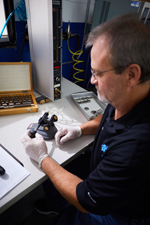Lubricated ball bearings carry a shelf life and utilizing them beyond this period can negatively affect performance. Unfortunately, determining that shelf life precisely is often elusive.

AST routinely lubricates over a million bearings each year and our equipment and processes conform to industry standards. For our internal lubricant control program, we rely on the recommendation of the lubricant manufacturer. Therein lies the problem for us in specifying a precise shelf life: We do not manufacture the product. In fact, the manufacturer’s shelf life designation in most cases refers to the storage life of the lubricant in its original container based on specific storage conditions. Once a bearing is lubricated, users must establish a new expiration date, or “storage life” based on the type of lubricant, packaging, and storage conditions of the bearings.
To assist our customers in this regard, AST Applications Engineers have worked with industry leading tribologists to develop guidelines and recommendations. These recommendations are based on the type of lubricant, such as oil or grease, the type of base oil, and the temperature and humidity levels expected during storage.
Most of today’s lubricants are quite stable and a bearing lubricated with grease with a synthetic base oil should have a storage life of between 24 and 60 months, or longer. Guidelines for bearings used in regulated industries, such as aviation, are more stringent. We continue to stay abreast of the latest developments in lubricant technology and refine our recommendations accordingly.
When a lubricated bearing has reached its expiration date, the user can elect to conduct testing to determine if extending the shelf life is appropriate, or, if of a suitable type, the bearing can be cleaned and re-lubricated. This choice of replacing the lubricant is often one of cost effectiveness. Scrapping or replacing the bearing is often the most cost effective choice. It’s not a one-size-fits all proposition, but one that involves multiple considerations.
To learn more about lubricant shelf life, download our white paper, “The Shelf Life of Lubricants in Precision Ball Bearings.”
And to learn more about lubricants, visit the AST Bearing Resource Center.

